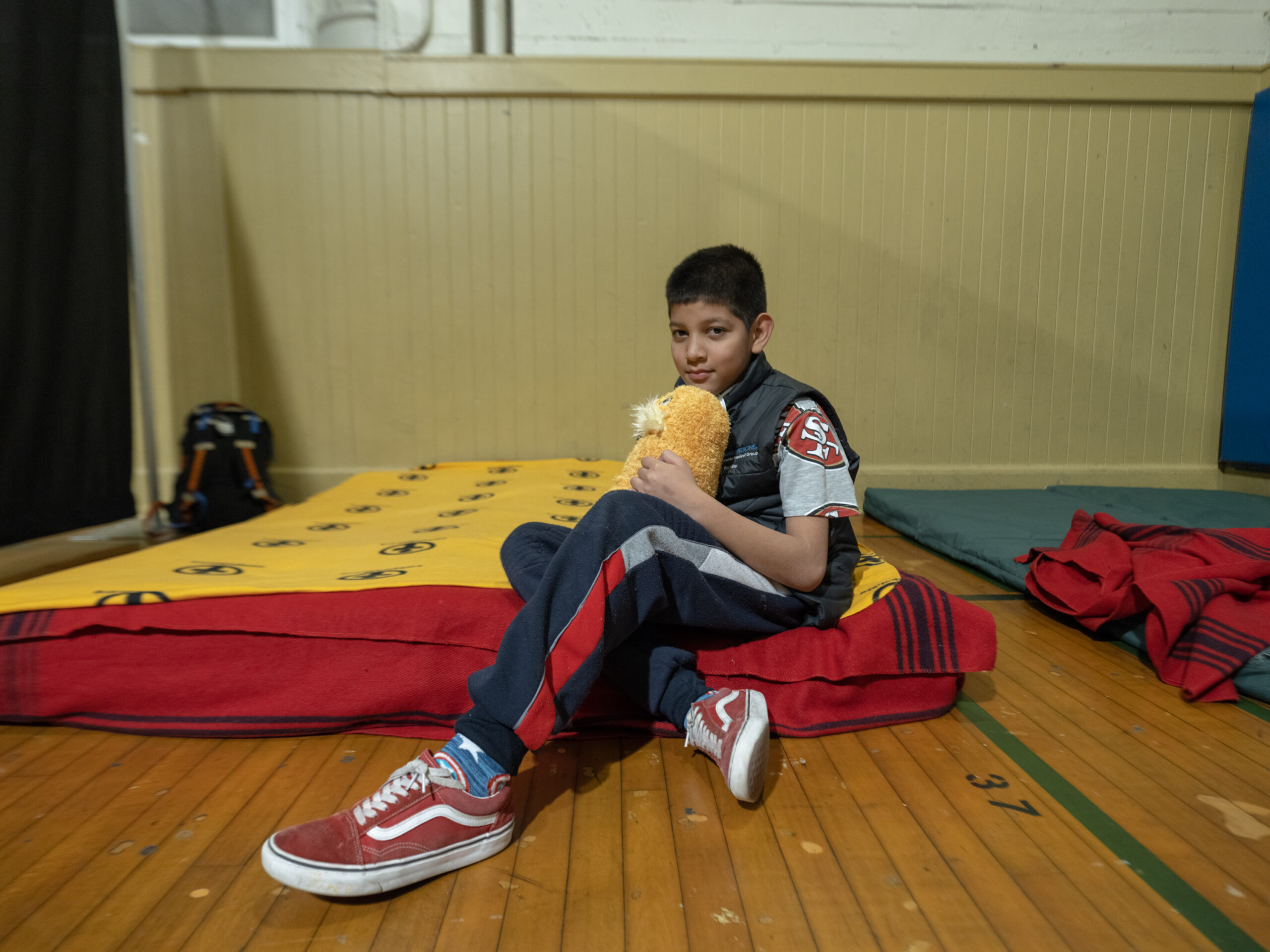Since arriving in San Francisco from Nicaragua in September, 11-year-old Enyel Cruz has learned the value of a good night’s rest.
At a unique shelter for public school children and their families at Buena Vista Horace Mann K-8 Community School, the soccer-loving sixth-grader sleeps on a mat laid out in the gym alongside his parents and his 15-year-old sister. During the day, the mats are piled up to make room for regular student activities at the bilingual Mission District school.
“In Nicaragua, I slept well,” Enyel said in Spanish through a translator. “Here, my back hurts.”
In the afternoons, Enyel stays in an afterschool program while his sister does her homework at a McDonald’s. In the evenings, the whole family then links back up to enter the shelter. The next morning, they wake up at 6 a.m. to clear out. The kids go back to school, while parents Juan Gomez and Silvia Cruz look for work as they await help on their asylum cases.
Gomez, who grew up on Guerrero Street before he was deported to Nicaragua, praised the stayover program, which is run by Dolores Street Community Services. But the constant back-and-forth wears on the family.
When asked what he wants in a home, Enyel’s answer was simple: “To eat well, be stable, not have to get up at 6 a.m.”
“It’s hard on us to be able to get up in the morning,” Gomez said of the shelter. “Especially when you have nowhere to go. Not working and sometimes not having money, you know, it affects you a little bit. Also, I don’t like seeing my kids like that.”
A Rise in Family Homelessness
The Gomez-Cruz family is part of an uptick in families experiencing homelessness in San Francisco. The phenomenon is partly driven by job loss, the high cost of living and a surge in asylum seekers. The city logged 616 unhoused families enrolled in response programs in the last quarter of 2022, up from 578 families in the prior three months.
At a Jan. 13 hearing on family homelessness called by Supervisor Hillary Ronen, the Department of Homelessness and Supportive Housing said the city enrolled 493 families in its homeless response system during the same fall/winter period of 2021.
San Francisco Unified School District tallied 2,061 students as experiencing homelessness, self-reported by their families. In its count, the district includes students living in SROs or doubled up with other families.
Of the 2,090 homeless students in the 2020-21 school year, 44% were Latino, 24% were Chinese, 14% were Black, and 4.7% were Filipino.
An impending closure of the Oasis Family Shelter in December led to a shortage of beds in the overall family shelter system, leading families to camp outside Buena Vista Horace Mann (BVHM) while waiting for a spot. Since then, Oasis reopened, and the capacity of BVHM’s stayover program increased.
In the overwhelming number of cases, households experiencing homelessness are headed by women. This year, the city will add a couple hundred units of permanent supportive housing for families and another couple hundred to subsidize rent.
But sooner or later, demand may exceed even that increased capacity.
“We’re riding the very, very edge of our capacity limits,” said Richard Whipple, interim director of the Office of Civic Engagement and Immigrant Affairs. “Nonprofit partners are well beyond their capacity. Every day more folks arrive. We’re in a very precarious situation.”
‘All Beginnings Are Hard’
Families seek shelter as a result of housing instability through loss of jobs, eviction notices they don’t fight out of fear, by being released from immigration detention centers, or by seeking jobs from rural areas where they may wind up living out of their vehicles. Many families that Dolores Street Community Services works with either have a history of domestic violence or are in the middle of it, according to executive director Laura Valdéz.
The uptick is driven, in part, by a surge of asylum-seekers. Of the over 620 immigrant students to arrive in SFUSD in 2022, over 80% are asylum seekers like the Gomez-Cruz children, according to Whipple.
Of the 10 families staying at the BVHM shelter as of Jan. 13, three are from Peru, and three are from Nicaragua, while others are from El Salvador, South Africa, Slovakia, and Guatemala.
Jose Mendoza and Maritza Guiterrez settled with their children—ages 6, 15 and 22—at BVHM’s shelter last week after fleeing Nicaragua’s political instability.
Until their asylum case is heard and a lawyer assigned to them, both parents lack work permits for better job opportunities and the stability for their families that comes with that.
According to Whipple, the San Francisco Immigration Legal Defense Collaborative is seeing “record waitlists for representation.”
“You couldn’t have peace in the streets,” Mendoza, an electrician, said in Spanish through a translator. “We don’t have another option. All beginnings are hard.”
Mendoza said his 6-year-old thinks the back-and-forth “is like a game.” His 15-year-old was waiting to start school at SFUSD while his 22-year-old, who had to drop his pursuit of a degree in Nicaragua, was in the process of enrolling at City College.
At age 11, Enyel is already seeing a future past this instability. He’s known for a couple years now that he wants to be a soccer player like Cristiano Ronaldo or a lawyer. The first career choice he identified is to be an architect.
“To make a house,” he said.
